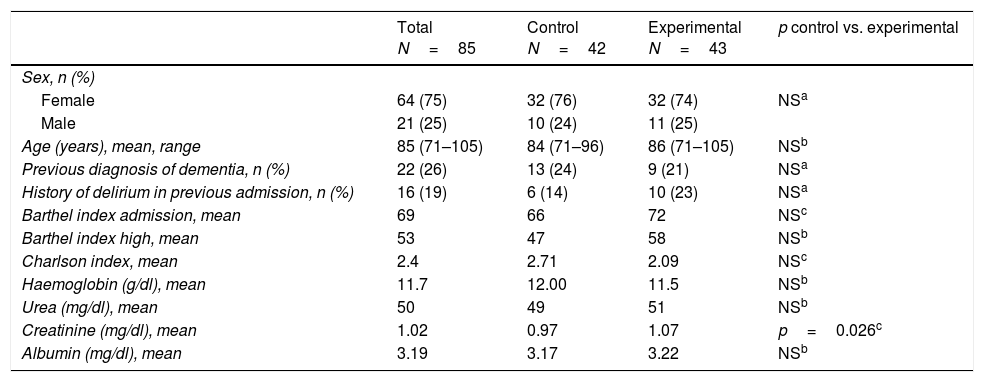The objective of this study is to evaluate the efficacy of a change in the management of the risk of delirium in an orthogeriatric unit.
Material and methodsProspective, comparative, non-randomised study of two cohorts of patients. One cohort (control group) treated with standard therapy with tramadol rescue and diazepam and another cohort (experimental group) treated with rescue with morphine at low doses and short half-life benzodiazepines as well as preventive treatment with neuroleptics in patients at high risk.
ResultsEighty-five patients were included (42 in the control group and 43 in the experimental group). Mean age: 85 (71–105). Twenty-nine patients (34%) had an episode of delirium during the current admission, 16 patients (38%) in the control group and 13 patients (30%) in the experimental group respectively (p=0.498). The mean duration of delirium in the 29 patients who presented it was 5.3 days. This duration in the control group was 6.6 days and in the experimental group was 3.8 days (p=0.031). In the group of patients who had previous delirium, a lower incidence of delirium was seen during the current admission in the experimental group (80% vs. 17% p=0.036).
ConclusionsExperimental treatment has been effective since a trend to a lower incidence of delirium has been observed. In the patients who have suffered an episode of delirium, the treatment served to decrease its duration with statistically significant differences.
El objetivo de este estudio es evaluar la eficacia de un cambio en la estrategia de manejo del riesgo de delirium en una unidad de ortogeriatría.
Material y métodosEstudio prospectivo, comparativo, no aleatorizado de 2 cohortes de pacientes. Una cohorte (grupo control) tratado con la terapia estándar con tramadol de rescate y diazepam, y otra cohorte (grupo experimental) tratado con morfina a dosis bajas de rescate junto con benzodiacepinas de vida media corta y tratamiento preventivo con neurolépticos, en los pacientes de alto riesgo.
ResultadosSe ha incluido a 85 pacientes (42 en el grupo control y 43 en el grupo experimental). Edad media: 85 años (71-105). Un total de 29 pacientes (34%) han tenido un episodio de delirium durante el ingreso actual, 16 pacientes (38%) en el grupo control y 13 pacientes (30%) en el grupo experimental, respectivamente (p=0,498). La duración media del delirium en los 29 pacientes que lo presentaron fue de 5,3 días. Esta duración fue en el grupo control de 6,6 días y en el grupo experimental de 3,8 días, respectivamente (p=0,031). En el grupo de pacientes que tenían antecedente de delirium previo, se aprecia que hay una menor incidencia de delirium durante el ingreso actual en el grupo experimental (80% vs. 17%, p=0,036).
ConclusionesLa terapia experimental ha resultado eficaz, ya que se ha podido observar una tendencia a disminuir la incidencia del delirium y en los casos que lo han presentado la terapia sirvió para disminuir su duración con diferencias estadísticamente significativas.
Artículo
Comprando el artículo el PDF del mismo podrá ser descargado
Precio 19,34 €
Comprar ahora










